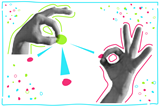Use this research-informed framework to help your students get ahead

Historically, educational psychology was dominated by Skinner’s behaviourism theory, where students are perceived as blank slates to be imprinted with novel external knowledge. Over recent decades, though, our understanding of the learning process has evolved, and it is now typically thought of as a form of information processing in which students actively transform and extend their existing knowledge. Ultimately, teaching is a process of knowledge transfer, but the exact mechanisms students use to assimilate the knowledge their teachers want them to learn are complex.
A recent study describes an instructional framework called step back, translate and extend (SBTE), which draws on the modal model of memory. The authors implemented SBTE in a bridging course designed to support students moving from general to organic chemistry courses at a US university.
Three cognitive processes
The modal model of memory describes a series of cognitive processes that lead to the transfer of information through three memory compartments: sensory, working and long-term memory.
We receive sensory information continually and in abundance, but it tends to fade within seconds. Attention is vital, as this modulates the sensory information which goes to the working memory. Rehearsal or rote repetition can increase longevity in the working memory. But when new information is introduced, this exceeds the capacity of the working memory and we forget prior knowledge. It’s more effective to encode information from the working to long-term memory. This means making connections to prior knowledge – and the longevity of new knowledge is linked to the quantity and quality of those connections. Once encoded, this information can be retrieved back into the working memory when needed.
Teaching tips
- You can adapt the step back, translate and extend (SBTE) approach for a range of teaching situations. It’s most useful when new material is strongly underpinned by theory students have encountered previously.
- Use learning objectives to help students focus on and avoid filtering out important information. This will help them encode it into long-term memory. Guide them in recognising links to previously-learned material. Then review foundational concepts, and highlight similarities and differences in problem solving between the two contexts.
- Scaffolded problem solving involves working through a sequence of small subproblems, rather than solving a larger problem independently. Guide students through the sequence, or you could design an assessment tool to support this process. Pinpoint specific errors in their thinking or problem solving and provide immediate feedback.
- You can sometimes hinder transfer by using excessive jargon or discipline-specific terminology. Minimise the use of new terminology and clearly define it when it is necessary.
- Use distributed practice (retrieval practice split across several short sessions) and interleaving (retrieval practice of different topics simultaneously) to help students independently solve problems. This will help your learners more effectively encode the information into long-term memory.
Step back, translate and extend
Knowledge transfer begins when a student realises that their current learning goals are like previously learned content – the recognition step. The first stage of SBTE, step back, aims to enhance recognition and recall by presenting learning objectives that help students focus on important information and giving them questions that trigger recall of prerequisite knowledge.
Most students reported an improved ability to recognise connections to previously covered material
The next stage, translate, deepens connections between prior knowledge and the new context, with an emphasis on underlying scientific principles. Scaffolded problem solving is the best approach at this stage. Scaffolding provides students with just enough support to engage in complex learning tasks, while ensuring that cognitive processes are directed away from irrelevant details.
During the final phase, extend, students independently solve problems in the new context. In this stage, retrieval practice is the recommended strategy.
The authors examined the role of SBTE in the beneficial aspects of the bridging course using semi-structured interviews. They interviewed 14 students across a range of attainment levels after they had completed the organic chemistry course.
Most students reported an improved ability to recognise connections to previously covered material and to recall concepts. A majority reported improved ability to apply their knowledge, with the continuous and explicit reinforcement of connections being cited as important. The interviews also revealed that the SBTE framework had a positive impact on students’ self-efficacy.
Reference
D Torres et al, J. Chem. Ed., 2023, 100, 12, 4696–4706 (doi.org/10.1021/acs.jchemed.3c00964)
David Read
References
D Torres et al, J. Chem. Ed., 2023, 100, 12, 4696–4706 (doi.org/10.1021/acs.jchemed.3c00964)














No comments yet